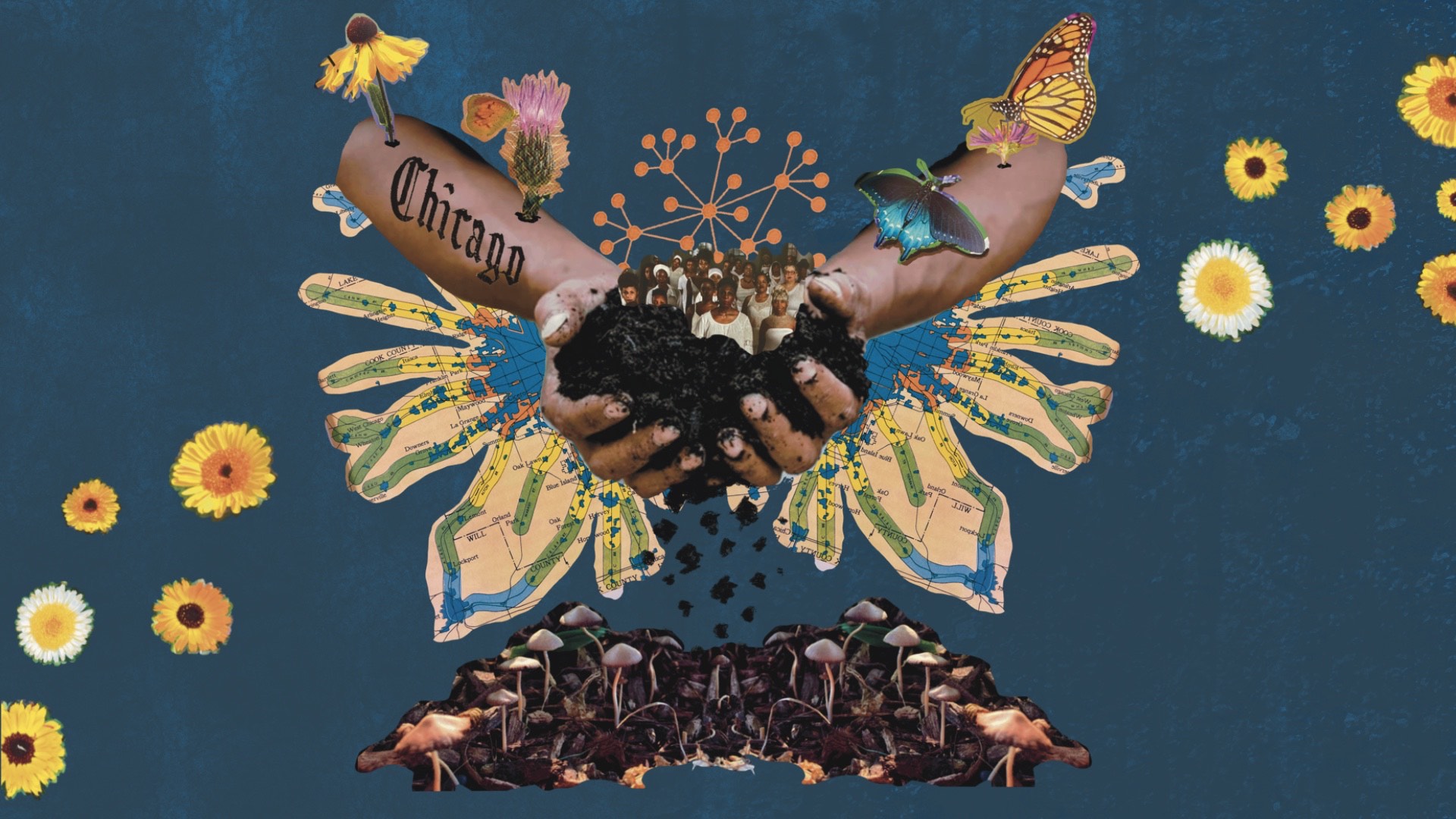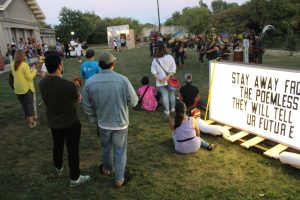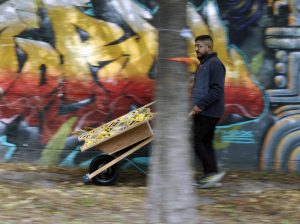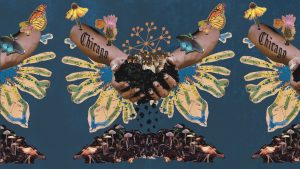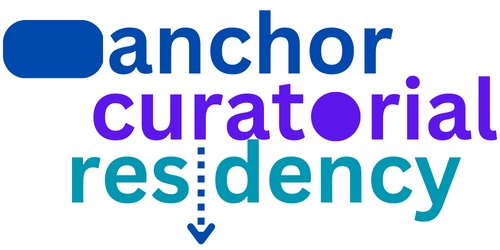
This interview is part of Anchor Editorial, a collaboration between Sixty Inches From Center and Anchor Curatorial Residency. This five-part series is co-created and written by Carlos Flores, this year’s Curatorial Resident, and Tiffany M. Johnson, who co-designed the residency with the Chicago Park District and was Anchor’s 2022 Curatorial Resident. Together, they will be publishing conversations with fellow curators, artists, and collaborators, as well as experimental essays and archive dives that explore the topics that impact their curatorial practices.
Para leer este artículo en Español, presione aqui.
Prompt: What does it entail to exist in a public space for you? How do you perceive its sensory aspects — feel, taste, look, and smell? What are your most imaginative and liberation-driven visions for public spaces?
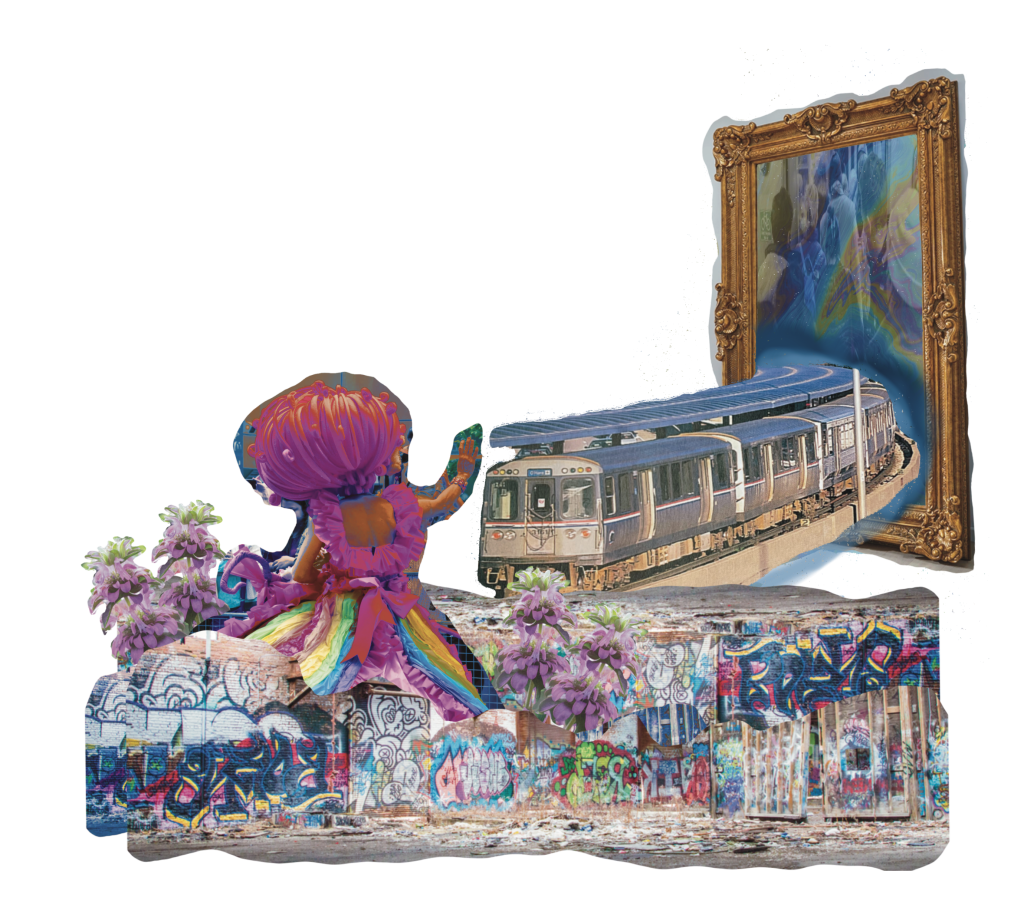
“Well for me, existing in public space is very much tied to performance. Of course I’m aware that I walk through public space everyday, just as a commuter, a traveler, a citizen. But there is a heightened sense of attunement to how my body relates to other bodies in public space when I have dropped into the mode of liveness and performing under an augmented physicality. To be more specific—emerging into the public space in drag. I feel like a sharp reflective surface, like a mirror, contoured and bent to a warp in certain places. A mirrored surface who’s ever-shifting sheen, like that of an oil-slick, I can use to shield myself with. All the while I’m able to also expose myself entirely for moments at a time all while reflecting those around me, letting them see a bit of themselves in me: their desires, their fears, their pain, their hopes. The performing body agitates the social contract and unapologetically confronts those around it in space. My hope here is that this confrontation, or rather this moment of unadulterated connection, becomes the site for the commons, the catalyst for a bridge to materialize. This is too often the risk of liveness and performing loudly as “the other”—you never know how the public will react to their own reflection. I dream that people approach ‘the other’ in public space, leaving fear at the door, and instead with a genuine curiosity for what makes us human and [results in] a new perspective.”
–Ále Campos (they/them)
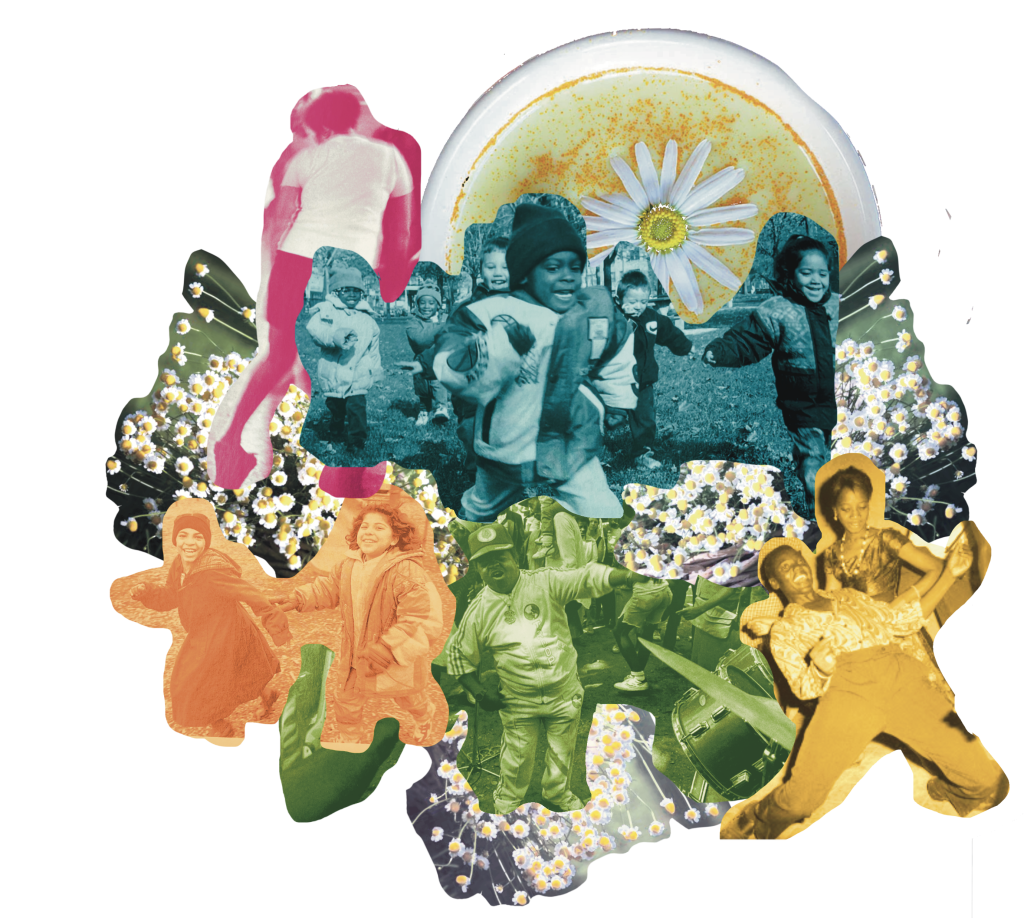
“Existing in public space is acknowledging the stories from those who came before us in order to honor future seeding with diligence for what we want to see after us. By having an interconnected understanding of how spaces were constructed we can propagate from a space of intention, connection, responsibility, and care. The sensory aspects of public space include laughter, children playing, rustling greenery, and soothing chamomile offering the scent of recovery. It tastes like the joy of collectively experiencing house music and dancing on a warm day with a sudden burst of rain—a very Chicago moment rooted in possibility and freedom.”
–Silvia Gonzalez (She/Her)
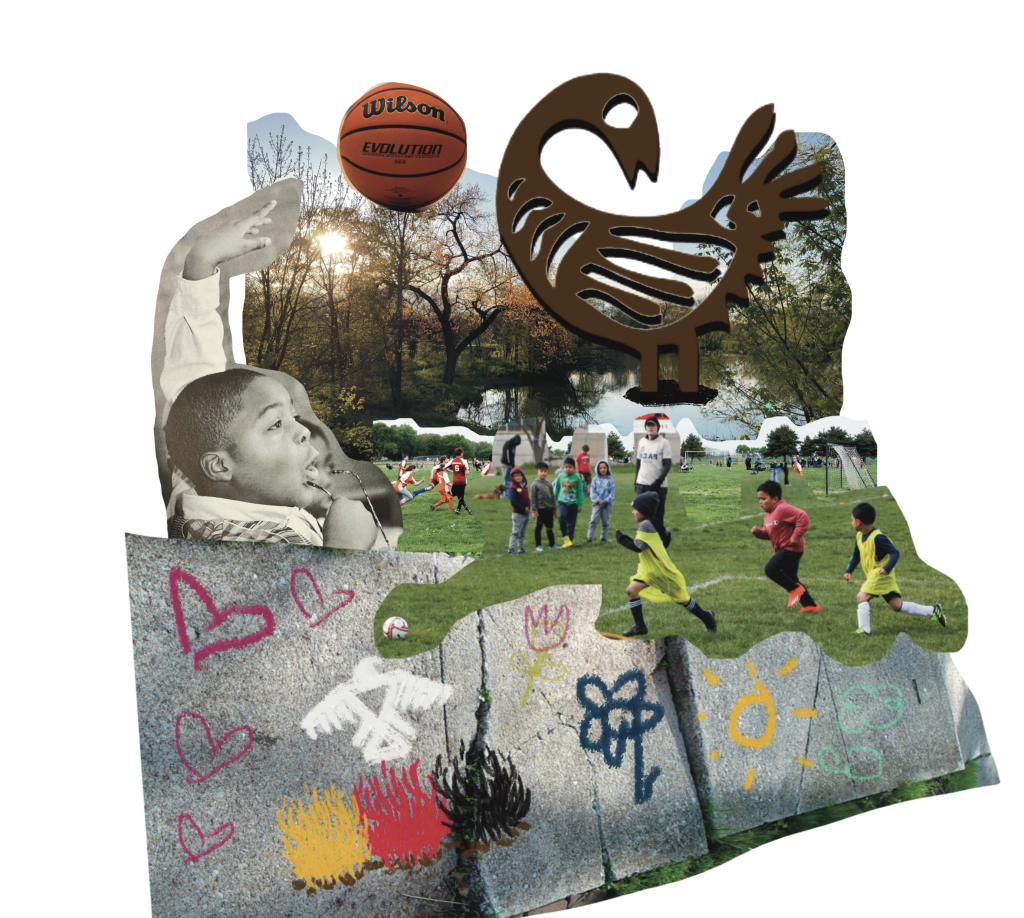
“When asked “ what does it entail to exist in a public space for you?” I was told to look up!
On the chalked cement of the South Shore neighborhood, a group of boys played soccer on ripe turf. While to the right, young brown boys tussled with basketballs and skidded across the blue concrete. Just a few yards over, I could hear the Nigerian accents of energetic soccer players talking shit with their neon vest and glowing skin.
If you want to see the history of Chicago just look up.
Point Dusable Baptiste, a Haitian and French explorer traversed this land and married an indigenous woman of the Potowatomi tribe known as Kitihawa. A city [was] founded by the children of the Black Diaspora and Indigenous heritage. How could I not imagine a city embraced and enlivened by the plethora of cultures that breathe into the lakefront air.
I perceive the sounds as an intermingling of West African, Venezuelan, and Chicagoan dialects. Each brown skin child gets kissed by what’s left of the summer evening sun. Historically segregated boundaries have no place in the warmth of this sun.
It costs a step across language barriers to feel liberated in my mind. Time is neutral so I imagine that this city is constructive with the exodus of people it receives this time.
It looks like the sight of ornate gardens filling in the vacancy of abandoned lots on the South and West sides. The closer our proximity to nature the closer we come to ancestral ties.”
–Dawn Johnson (She/Her)
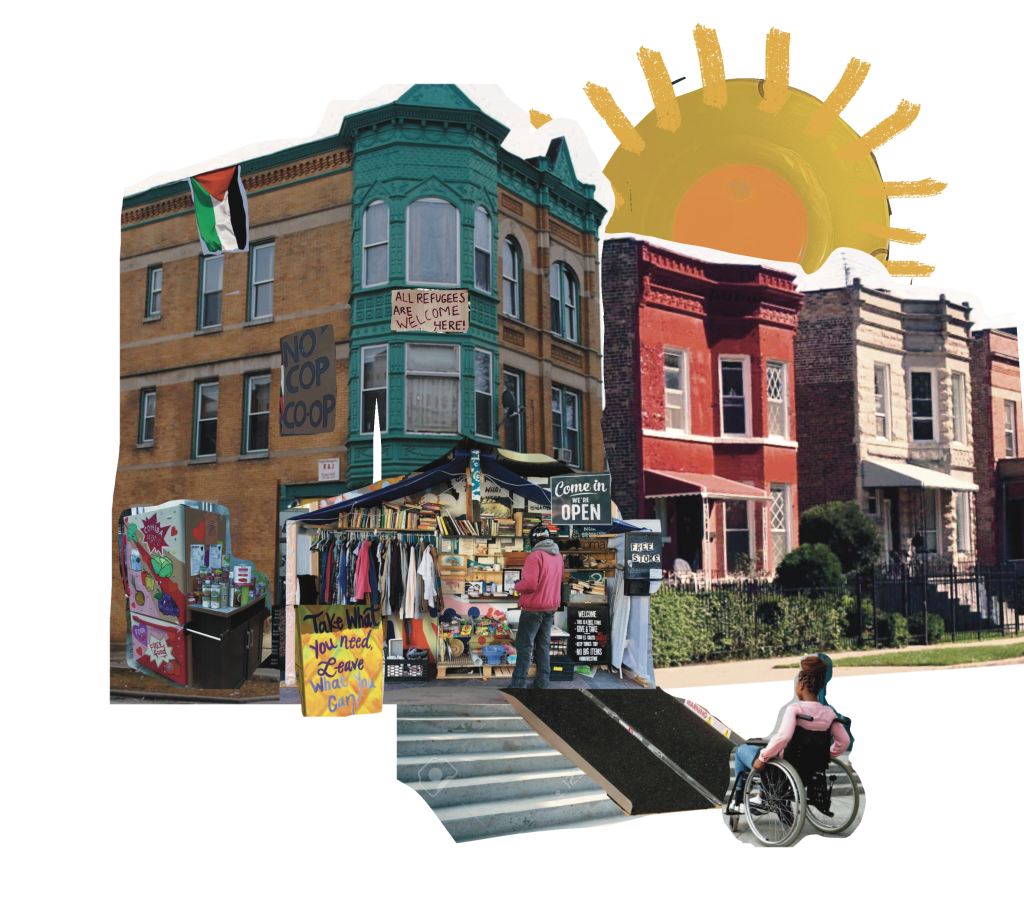
“To exist in public is to take a risk, a leap of faith, to actively participate in co-creating our shared ecosystems. When I enter a public space I consider: how is my presence impacting this space? How am I making this space safer? More joyful? More liberated?
I dream of public spaces that center children and elders, people with disabilities, those who are neurodivergent, BIPOC & LGBTQIA+, immigrants and refugees, and all who exist on the margins of society.
I dream of public spaces that center joyful consent, harm reduction, restorative and transformative justice. I dream of systems of care that don’t involve the police. I dream of public spaces where safety and freedom can co-exist and we practice learning and growing together from a place of curiosity.
I dream of public rituals, ceremonies, processions, intertwining creative practices, radical experiments, free stories, open libraries, wildflowers and native plants, opportunities for us to connect deeply with the Land and our more than human kin.
–Irina Zadov (they/them/she/her)
“Another world is possible, on a quiet day I can hear her breathing” –Arundhati Roy
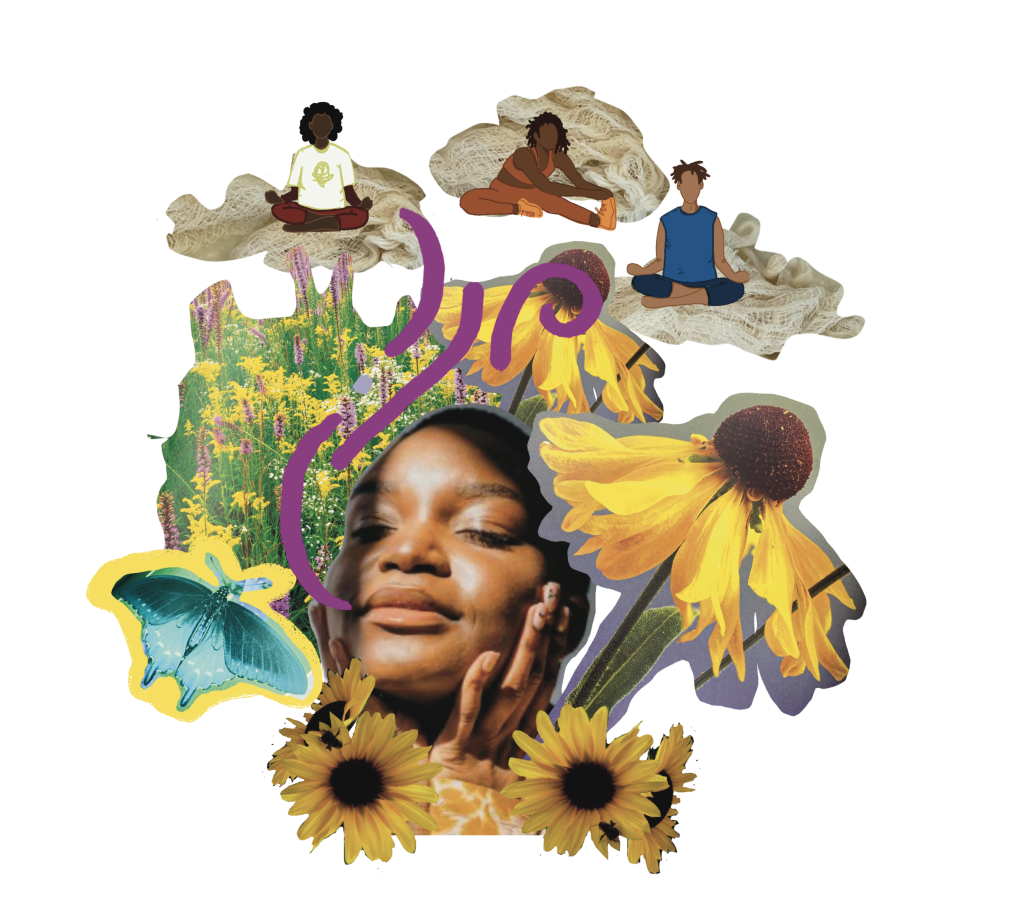
“Existing in a public space is the body island transiting in its authenticity without restriction, border, or opposition. True public space is an opportunity to converge with others, to share and to be as you are, without imposed patterning.
Public space is the hair follicles that point toward the sun from the chilling breeze. The lush tapestry of native flora and fauna placing your eyes into meditation and humming along your skin as you glide by in prayer. A kaleidoscope of memories that you eat every inhale and exhale new memory into the wind.
Liberation embodied.
We no longer call these spaces public. We are as they are. We call their names and they call ours. Nature. We belong because we aren’t questioning if we belong. We fall in love. We cry and dance and sing together and apart. We undulate to the pulse of the earth in and around us without worry. We are as we are and that is alright. It’s better than alright, because we’ve arrived forever, together.”
–Najee-Zaid Searcy (Any/All with respect and intention)
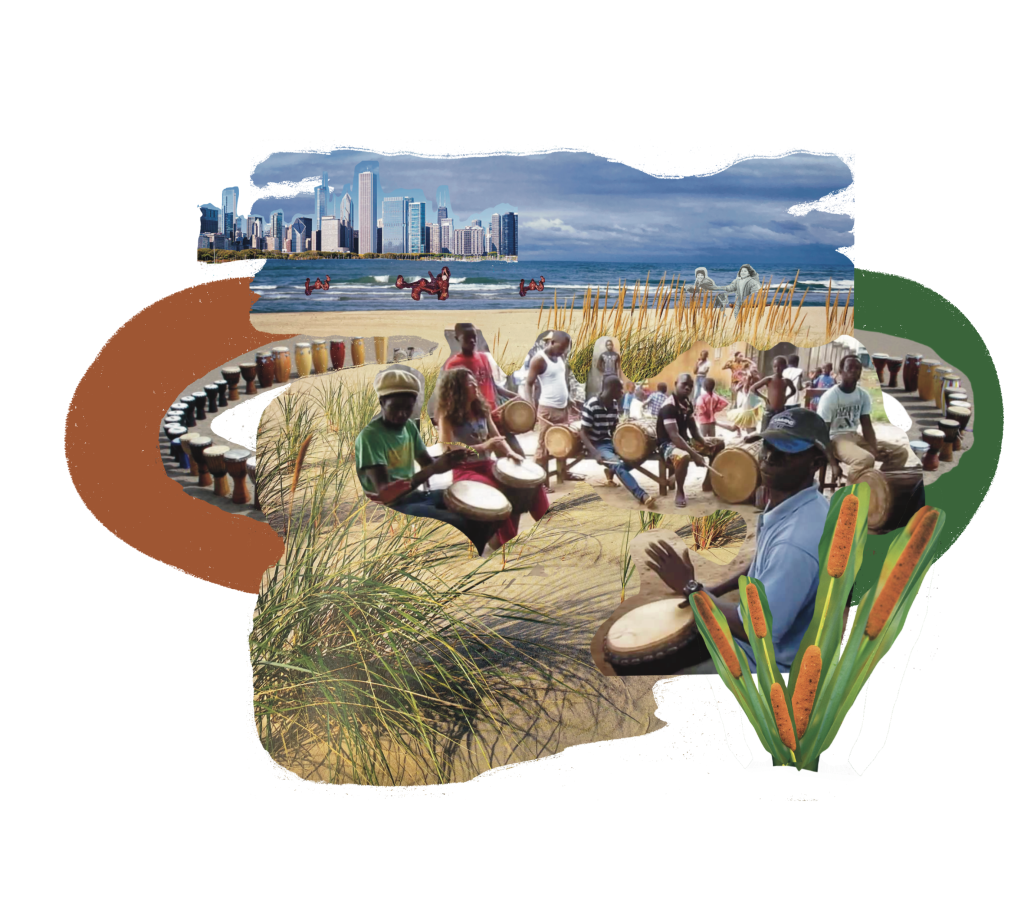
“I firmly believe that at their very best public spaces offer us opportunities to practice how we can be together in ways that are both life-giving and spiritually nourishing. When I close my eyes and imagine public spaces in the future, I see spaces that invite and encourage us to be deeply embodied and profoundly connected to our communities. I picture spaces that are so generous and expansive that all life is able to flourish in them. I see public spaces that honor the deep connection with our sacred home and reflect our interconnectedness with all life on this planet. They are public spaces that invite us to expand our circles of care and consideration. Spaces that encourage us to grow and tend the softest parts of ourselves.”
–Angela Drakeford (she/they)
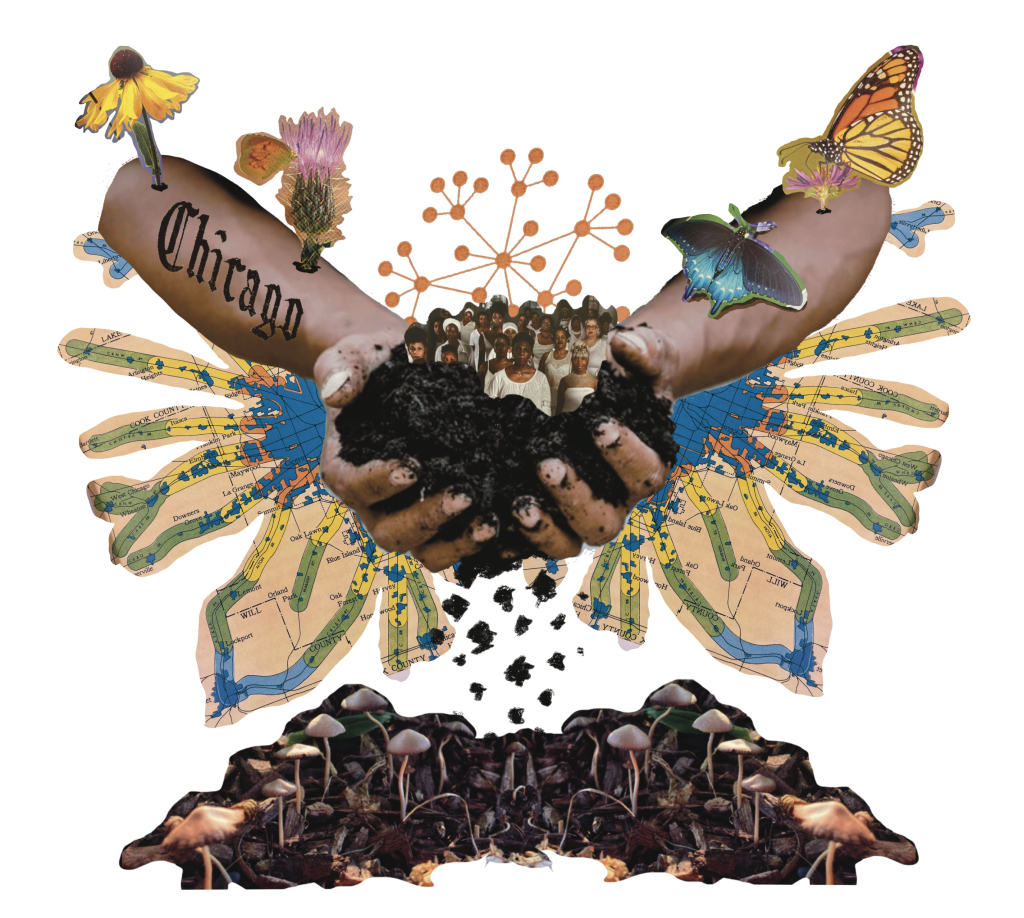
“It feels impossible to think of existence without considering the immense toil and labor that soil has had to hold. Soil, like many public spaces, is made up of millions of living things, micro into macro, all working to support much of what we rely on. These processes all happening on a microscopic level, unseen by humans. The women in my family had a saying for the phenomenon of disregard for the unseen:
“ojos que no ven, corazón que no siente”
“eyes that don’t see, heart that doesn’t feel”
Existence on public land means being in solidarity with those who cannot be perceived outright… It means understanding that we are not absolved from the responsibility of regard + response.
Existence reminds me that we cannot survive here, without understanding that some iteration of liberated public space must mean working in opposition to ideologies dictated by colonization. If it has become commonplace to approach land devoid of care, we must extend care to it. If we are conditioned to exploit land and soil, we have to move towards being in service to its health. If the land has spent centuries in capture, we work to return it to its original caretakers.
Ojalá, here we can smell sweet licorice undertones of aged, fertile + bountied soil.
One that grows ecologies, food systems, and communities.
The beautiful irony of public space is that while we may not own it outright, we are the public, and we make up everything it is.”
–Nateo Carreno (they/them)

“Ideally, a public space would be a welcoming space. An environment that fosters sharing ideas, resources, and joy.
An overall feeling of calm is evoked when entering this community space. Entering the community space envelops participants in a welcoming atmosphere that appeals to their senses. Fresh flowers from the community garden fill the air with a sweet fragrance, while the gentle sounds of water from the nearby pond or lake provide a soothing backdrop. The aroma of food cooking from a community kitchen fills the air with the rich and robust smell of sofrito, the unmistakable aroma of cumin, and the sweet and citrusy scent of coriander. Together, these sensory experiences create a relaxing and comfortable environment for participants.
I envision a space that nurtures the community, both physically and spiritually. It incorporates an open-source library powered by the sun, offering free Wi-Fi access, to archives, and other resources. The library is housed in a geodesic dome containing a community garden and a kitchen within the atrium. In the center of the dome is a shared gathering space surrounded by a ring of flowing water, which invites everyone to come together.”
–Eric Von Haynes (he/him)
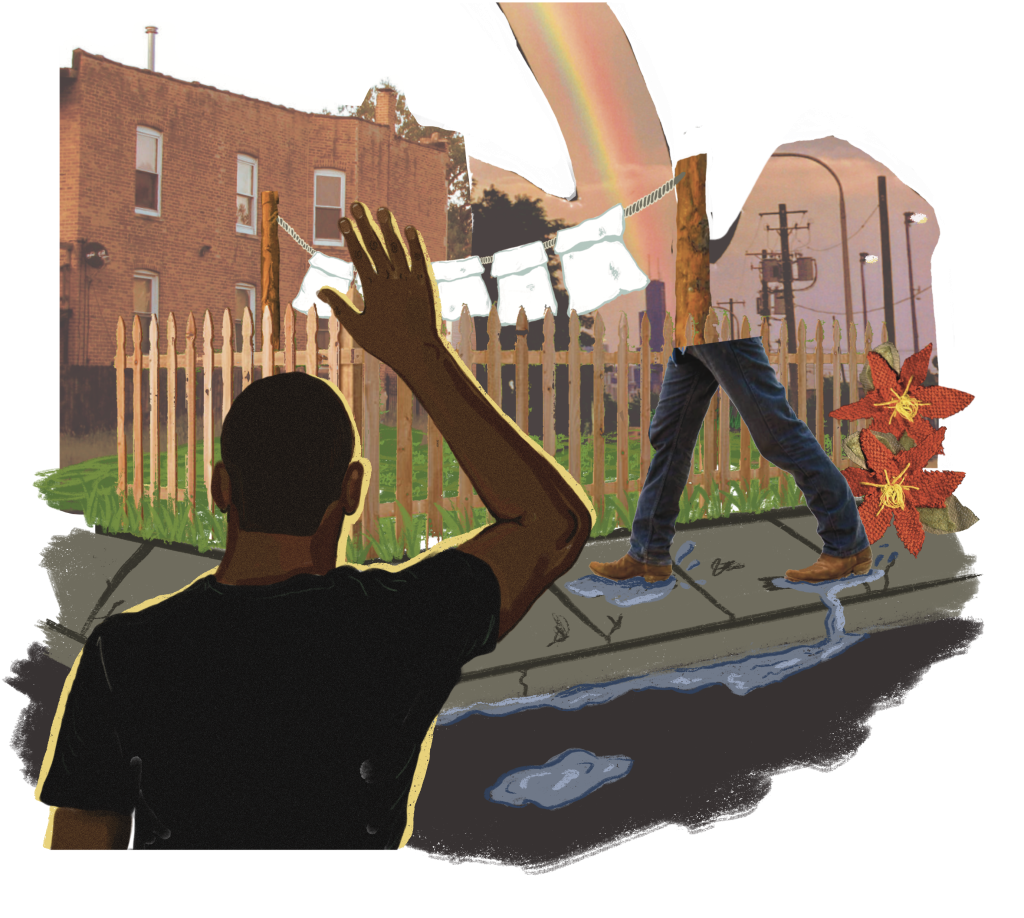
“Public space is the catwalk, product development, and quality check.
It is the domain in which we test the ideas of who we can be, who we want to be when others are watching.
It’s slight nods that remark on the fine ensemble that is you. Smiles that let you know you’re going the right way. Kind eyes that call you baby. It’s torrential downpours or heavy winds teasing and testing the fabric of your body, saying, “Try again next time.”
Public space makes everything green. We’re all a little sensitive, you see. Still taking shape and growing, expansive, wide open, eager for your marks to be made on my landscape. It is to strut, the clacking of cowboy boots on freshly rained pavement, white linens mirroring the flow of the wind, sweat kinda like glow kinda like seasoning. Wearing where you have been.
It’s limitless potential—climbing a tree, kissing at the stoplight, picking a violet—until it’s not. Someone looks at you. It’s whoever you must be within their look—pleasantly sane, enthusiastically the same, another set of eyes to not make contact with. Look down long enough and they’ll be gone. The space will be yours once again. Clack clack clack. You’re already on display.”
–Taylor Roberts (they/she)
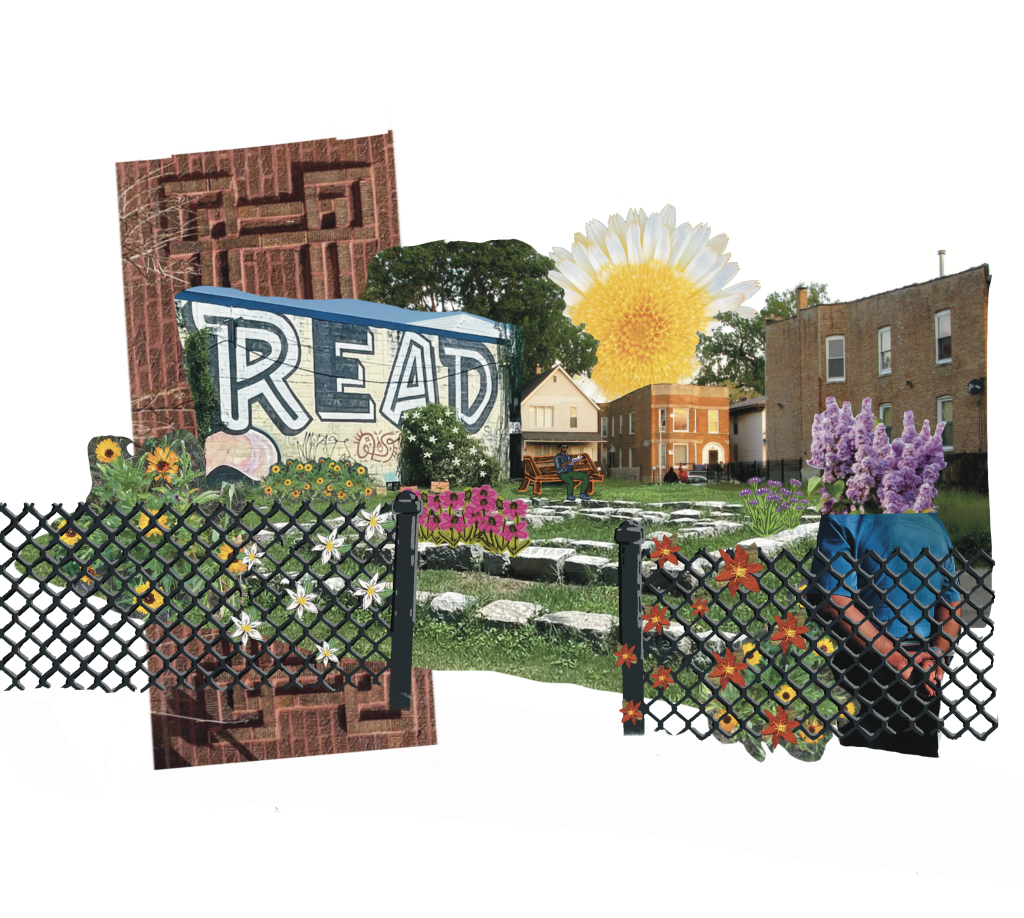
“I like my public spaces to feel like an oasis. As if I just entered a new dimension and my curiosity of the space overtakes my senses. I love the smells of a sweet aromas. I can never detect [it] but I always have a familiarly to vanilla and lilacs. It is always visually appealing, with a balance of greenery, and a rough industrial hardscape. I always enjoy the mix of metal and flowers. Such opposites intertwined beautifully.”
–yaritza guillen (she/hers)
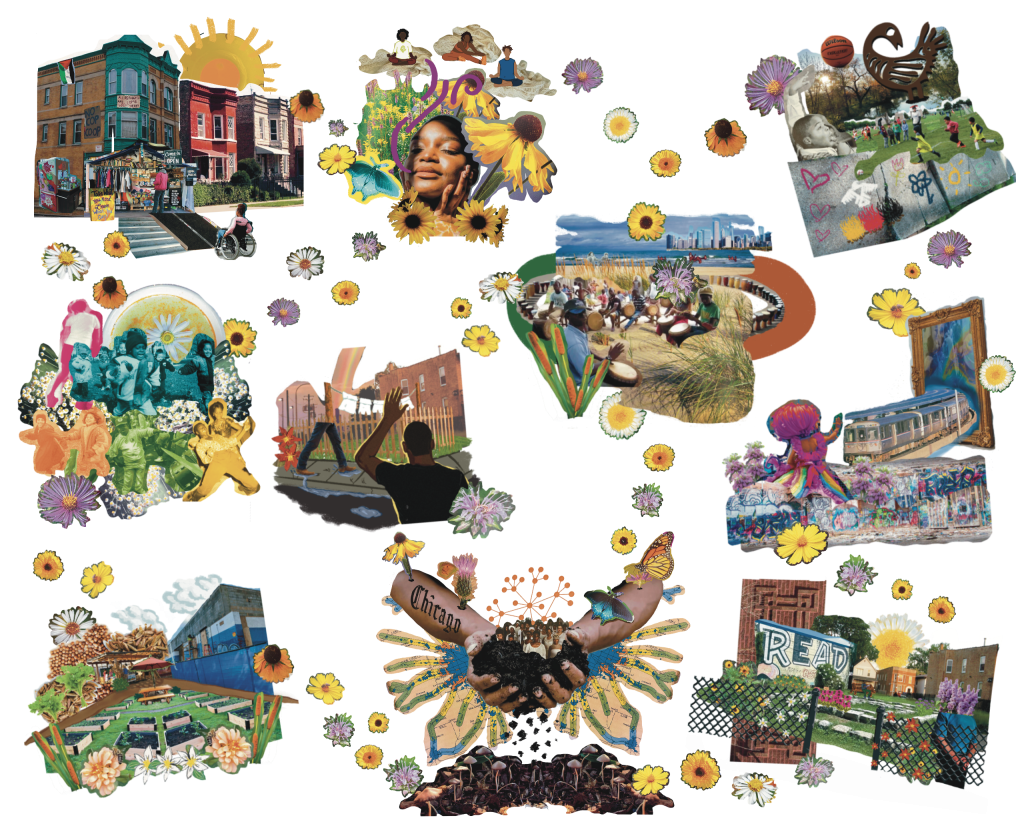
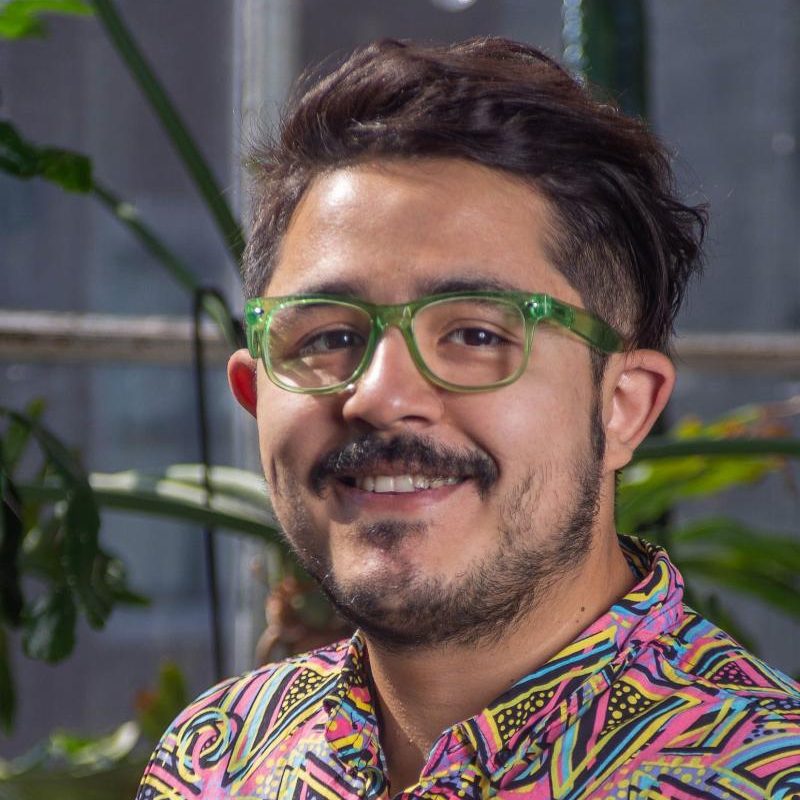
About the author: Carlos Flores is an installation artist, radical community arts organizer, curator, and flower farmer. Both his visual practice and organizing work center around creating space for connection, generation, and care to take place. As programs manager at the Chicago Art Department, he leads the organization’s residencies and exhibitions, supporting twenty civically minded artists and over 100 free exhibitions and programs every year. Carlos is also the founder of Contra Corriente, an annual festival highlighting the work of artists, activists, and organizations working to advance racial and environmental justice on the South West Side of Chicago and beyond. (Photo by: Miguel Vasquez | Instagram: @miguelphoto1)
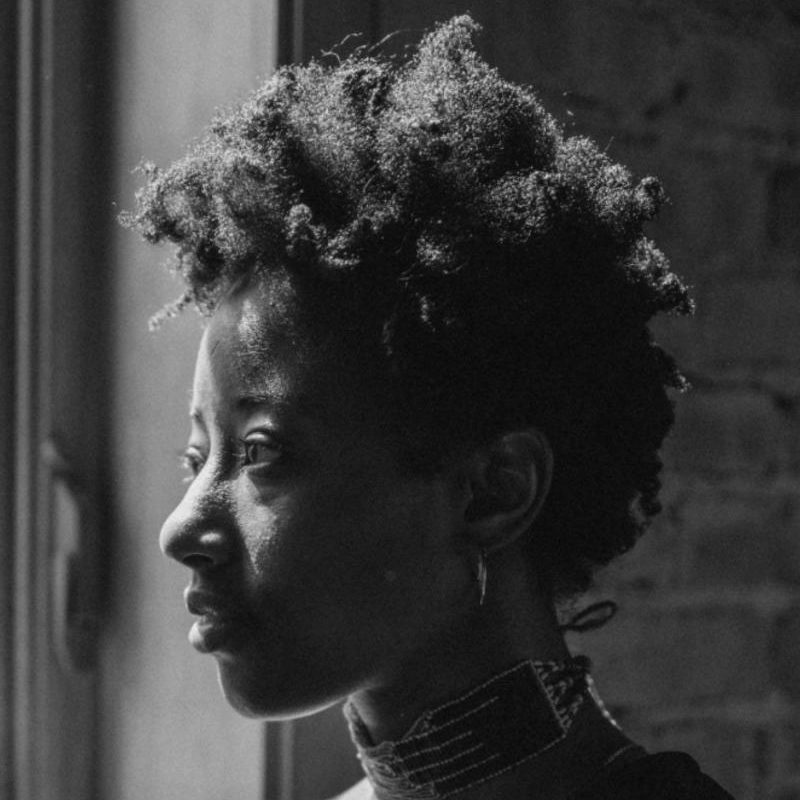
About the author: Tiffany M. Johnson is interested in spaces (and a world) where Black people can exhale. She is a researcher, survivor (advocate), and curator passionate about community building through imaginative, underground, and cooperative practices. She attended SOAS, University of London, for her Master’s in Migration and Diasporas Studies. Her studies continue through her DIY Ph.D., a long-term art and hood scholarship project on alternative ways of being within spaces combating oppressive structures. Through a radical afrodiasporic feminist lens, she is interested in rebuilding human-to-land relations and centering understudied subjects and community care systems. Tiffany is a 2022-24 Threewalls RaD Lab+Outside the Walls fellow and co-stewarding the development of the survivor support mutual aid group, Project Nebula.
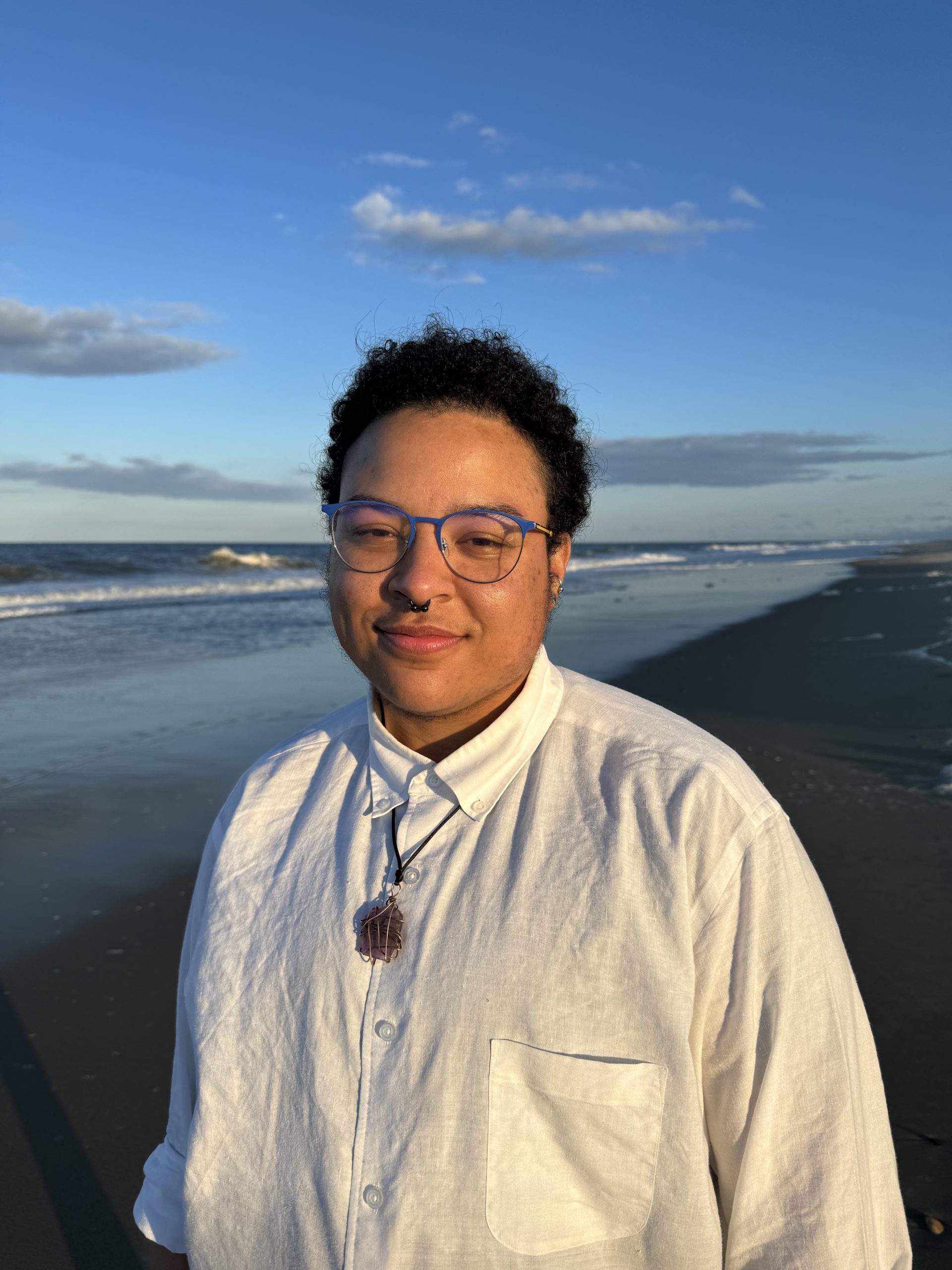
About the artist: darien hunter golston (as written; pronouns – he/him, ey/em or d) is an earthkeeper, domestic artist, full spectrum doula and sometimes writer living between Waawiyatanong and Zhigaagoong (Detroit & Chicago, respectively). d labors to create pockets where freedom, ease, pleasure, and play are possible for Black folk, centering the needs queer & disabled needs. he is devoted to the Land and to achieving reproductive justice for all in his lifetime. @earthybutchqueen
About the sound pieces: Marquette Park Youth Improv is composed of Randy Trubitt, 27 (reeds and woodwinds), Mike McCarthy, 27 (guitar), Beto Alegria, 21 (upright bass, tuba) and Matt Riggen, 31 (drumset and percussion)
About the Curators:
Ále Campos (b. 1994, Los Angeles, California) is a multidisciplinary artist and performance maker whose elastic studio practice is anchored in the vernacular of drag and their persona, ‘Celeste’. They generate live performance works that are often rhapsodic and mediated by technology, often involving or unfolding into the mediums of sculpture, sound, text, video and installation. Drag is the lens through which they consider performance making: they consider the stage and its borders, the malleability of the gaze, how to de/construct an image, the various states of in/visibility and how to handle time. Through exploring the malleability of vulnerability, their work dissects the psyche by declaring liveness and performance modalities as the catalyst for moving through states of becoming.
They received a BA from Bennington College (2016) and an MFA in Performance at The School of The Art Institute of Chicago (2022). They are currently a lecturer in Performance at SAIC and are an active, participating member of the drag and nightlife community in Chicago and are currently a resident performer / co-producer of Rumors, a monthly event that showcases some of the city’s premiere performers and DJ’s.
______
Silvia Inés Gonzalez is a multi-disciplinary artist, cultural worker, curator, and educator in Chicago creating spaces where collective wellness takes on critical dialogue, art making, and community building. Her visual and audio work is a ballad to nostalgia–the borderline between myth and memory. Silvia has curated and facilitated workshops to address structures of power, imagination, repair, collective care, play, confinement, and freedom.
As the organizer and administrator of (People of Color) Artist Space, she connects artists of color from across Chicago to resources through social meet-ups, salons, and development opportunities. Two extensions of POCAS include POCAS is Salon, which is a co-learning space for artists to connect across various topics and ideas, and POCAS + Friends–inviting intentional relationship-building as a means of support and care. Most recently, Silvia has developed Sala: A Living Room of Ideas on Lumpen Public Radio. Sala invites artists, cultural workers, and civically minded people to discuss liberation, education, organizing, community, and practices toward healing, from the perspective of Artists’ and their processes. She is a current Co-Lab resident at Chicago Art Department.
______
Dawn Johnson is an historian, teacher, and emerging curator. A native of Chicago with familial ties to Louisiana, Johnson amplifies the quotidian of African American history by creating conduits to foodways, literature, and oral histories. Johnson is a Golden Apple Scholar and Social Studies teacher at Art In Motion on the South Side of Chicago. She continues to enliven her teaching by drawing artistic and historical expression from her travels in Ghana, Dominican Republic, and New Orleans, La.
______
Irina Zadov is a mama, artist, educator, and cultural organizer. They are a queer post-Soviet anti-Zionist Jewish immigrant and settler on the unceded territories of the Three Fires Confederacy: Ojibwe, Odawa, and Potawatomi. Their practice explores themes of diasporism, state violence, community resistance, and healing.
______
Najee-Zaid is an interdisciplinary artist born in the lands of the Council of Three Fires Confederacy. Lands of the Ojibwe, Odawa, Potawatomi peoples and many other native peoples, plants, and elemental ancestors. Najee-Zaid uses lineage based practices to find home. Find more at najeezaidsearcy.com
______
Angela is an artist, gardener and writer from the Midwest who currently resides on unceded Ojibwe,Odawa,and Potawatomi land, so called Chicago,IL. Angela received their MFA in Fibers and Material Studies from Tyler School of Art. They received their BFA from University of Nebraska at Omaha. They have had residencies at the Bemis Center for Contemporary Art and Oak Spring Garden Foundation. Their work has been shown in various museums throughout the country, including Crystal Bridges Museum of American Art, Minneapolis Institute of Art, John Michael Kohler Arts Center, and Joslyn Art Museum. Drakeford’s work is in various public and private collections across the country including Crystal Bridges Museum of American Art and the University of Nebraska Foundation.
______
Nateo is currently a farmer, grower, and has cultivated and grown in public spaces since 2012. They study soil biology, plants, and lecture on queer ecology. These disciplines are how they understand the relationships between soil, land, people, and queerness. They grew up in Cicero, Pilsen, and Little Village. Their family is from Durango, MX.
______
Eric Von Haynes operates under the imprint Flatlands Press and co-founded Love Fridge Chicago, a mutual aid initiative supporting community fridges. In addition, Eric serves as a Visiting Senior Instructor of Graphic Design at the UIC School of Design. Currently, he holds the position of President at the Chicago Printers Guild.
______
Taylor Roberts is a Chicago-born curator, arts administrator, and cultural worker. Their work centers a Black queer feminist ethic. Taylor received her Bachelor of Science in Art History and Nonprofit Management from Oglethorpe University and is currently pursuing their Master’s in Museum and Exhibition Studies at the University of Illinois at Chicago.
______
Yaritza Guillen is an urbanist, storyteller, and unapologetic optimist. Her focus lies in interdisciplinary practices, community-based design, and story mapping. As a cultural producer and community planner, she has engaged in various projects, including the Nuestra Herencia: Legacy Film Project where she documented the experiences of elders in her community during the pandemic and is one of the We Will Chicago artists whose project involved designing a weather adaptable pergola at South Merrill Community Garden. She also led an Ethical Storytelling Training for Environmental Justice Lawyers with the Environmental Defense Fund.
